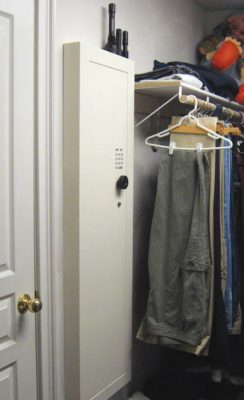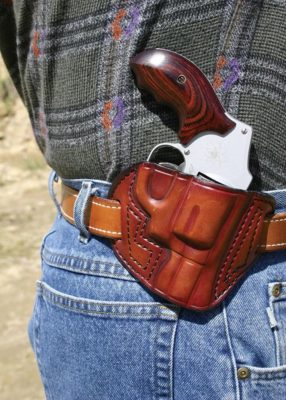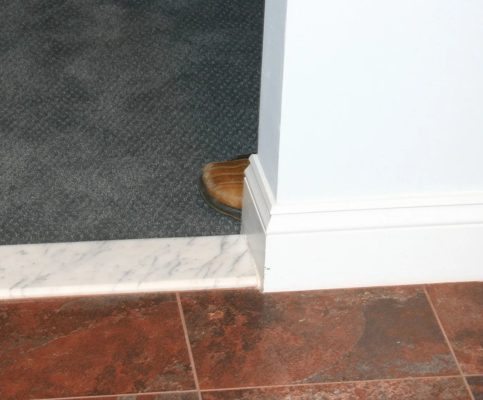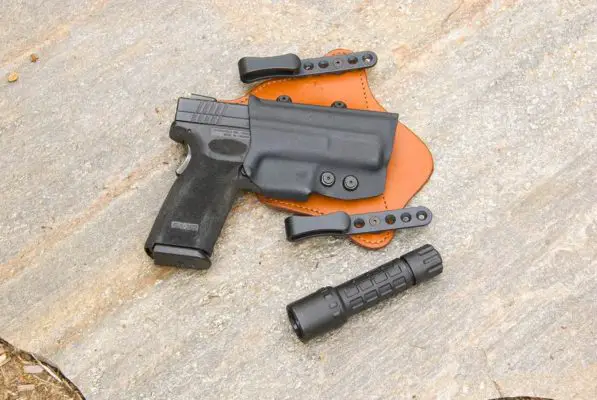Engaging myself in the firearms and training sectors, I often hang around with people who wear a gun on a regular basis. Such guys spend a lot of their work time in a “yellow” condition but they also let their guard down when they come home. No matter how hard it’s to accept, your house may be one of the most dangerous locations to meet a malicious attacker. There are 2 reasons why I claim that.

First of all, the majority of us feel comfortable and protected when at home, overlooking what is happening around us and living in a “white condition.” We are used to considering a wide variety of everyday sights and sounds as our neighbors’ usual come-and-go. Consequently, we sometimes ignore the hints that should alert our minds. Secondly, our defensive guns are not often at close range when trouble arrives and are most likely secured from unauthorized hands which retards our proper action. This poor awareness with a delay in getting and unsecuring a weapon may end up as a tragedy. Though it’s genuine to feel relieved in your own house, it’s not always the idealized location it appears to be.
One of the most rapidly rising segments of brutal crimes were home invasions. It’s worth assuming that someone ready to break into a home with residents inside is also ready to make use of deadly force against them.
A home invasion that catches you without protective measures can be a one-sided encounter since invaders are likely to be armed. In the case of do-or-die situations, you have no choice but to grab the weapon and get it into service. Many of the gun owners I’ve shared this with confessing that they seldom wear a gun at home. Besides, their firearms are generally locked, blocking the entry of curious hands. Although it is wise to protect weapons from children and other undesirable individuals, the downside is that the opportunity to obtain a weapon during a disaster is delayed or fully phased out.
In order to provide the quickest possible retrieval, weapons stored for self-protection should be locked in prompt action safes if they need to be secured. The trouble with a conventional firearm lock is the activation process. In high tension scenarios, attempting to type in a combination of using a key is almost always pointless. If you need to find a key before opening a gunlock, odds are you run out of time.

Think about your actual place while you are at home and ask yourself the following questions:
- Where is my gun kept?
- Where are the potential offenders to invade my home?
- What are the most used rooms for my family?
- Before the intruder harms my family or me, can I get my gun?
Though every situation and house has various characteristics, the solution for most people is to wear a gun at home to survive an invasion of their houses. Some may find this insane but if you reconsider the situation objectively, it may change your mind.
As an alternate option of carrying a gun, you can strategically place several weapons across your house. They may be kept without protection if you do not have children in your house (Local regulations allowing), yet continuous diligence must be assured to guarantee that prying eyes of burglars do not get to these areas. However, grabbing one of the stashed guns is not as fast as having one on your body, and it will cost you more due to the need for several guns.
Employing a deadly force

It blows my head off when some people say they’re going to kill someone who breaks into their house or shoot them when they leave. Self-defense in your house does not differ at all from the one in public. In the book The Law of Self-defense: A Guide for the Armed Citizen, Andrew F. Branca summed it up best by saying:
“Citizens may use deadly force in self-defense only when they actually and reasonably believe that doing so is necessary to prevent an imminent, unlawful, and otherwise unavoidable threat of death or grave bodily harm to an innocent person.”
Notice that there is no need for credible evidence, just a rational assumption that you are going to be severely injured or murdered. You don’t just state that you felt the attacker will harm you; you ought to adequately justify the grounds for concluding that argument.
It’s legally allowed to use equal power in defense.
Deadly force should be employed only if you protect yourself from deadly force. Although the rules of each state vary, the following are widely recognized standards for the legitimate use of lethal force: to warrant the use of deadly force, your attacker must have a capability or opportunity to kill or severely damaged, and you must be at actual or extreme risk.
Simply put, deadly action should only be used if there is an imminent and otherwise inevitable risk of death or severe bodily injury to the innocent.
This is highly important. Three factors must be present to warrant the use of deadly force:
- Capacity – Intruder is in power to kill or severely damage (strength, firearms, etc.)
- Opportunity – Intruder is given the opportunity to kill or severely damage (close enough)
- Jeopardy – Intruder must attempt to murder or severely damage.
Otherwise stated, fire if there is no other way to defend your life. You can protect other people as well (both family and strangers) with the same rules applied.
Arms can only be used against unarmed criminals in specific conditions. The principle of Disparity of Force suggests that if the unarmed intruder has more power than you, it is warranted to use a firearm. Depending on the actual case, these disparities often include men vs. women, size and strength, disabled persons vs. able-bodied, several invaders or one presenting a proven danger.
Entry of Intruder

Entry to your house can be accessed in two ways: force and authorization. The amount of home invasion entries achieved by merely banging on the door has risen significantly. Intruders pretend they need to get in, much often claiming they should use the phone for an emergency, such as a traffic crash. Sadly, most people who are kind-hearted and willing to support their fellow man would open the door to help.
It is clearly a bad idea to open the door to strangers. First of all, get verbal or visual acknowledgment when answering the door. Don’t open up the door for any reason if the person is unknown. There can be no justification for a stranger to get into your house. Hold the door shut if they claim to enter for using your phone, and offer to make a call for them. This would be enough if they had honest motives.
They are potentially malicious in their motives whether they keep asking for entry or alter the excuse of coming in, like using your toilet. In that instant, you should step back from the door to provide you with additional defensive distance and time. Instead of shouting at them to leave or informing them that you’re calling the cops, which can be followed by an instant aggressive entrance, you should mislead them to win time and take defensive measures. Just say, in a quiet voice, “OK, just give me a minute. I ought to put the dog inside since it doesn’t like strangers.”
This will help you with three things. It would make the attackers feel easy to prevent them from demanding a quick entry since they do not want to encounter a dangerous dog and stall time for you to retrieve your guns, call the cops, then gather your family to get to a secure place. This is a far safer choice than making them open the door directly to your face.
Handling 911

Note that when calling 911, not all 911 services immediately identify the caller’s location so it is necessary to send the address first. To make sure it is heard, speak gently and repeat it if needed. In this way, they’ll know where to send police forces if you hang up or get disconnected for some reason. It is a common protocol to respond to all 911 calls, even though the address may be the only detail they have.
Stay cool but show urgency in your message.
Make it clear to them that you require right away assistance. If you have a mobile phone, use it to switch into defense and keep contact available. As far as possible, present them the circumstances and describe criminals. Inform them whether you have a gun, give a description of you and your family members even with details on your clothes, so they know who the true residents are.
Related links: Arsenal Apparel
Planning self-defense
When the intruder is already in your house or in the midst of breaking in, be prepared to deal with many unforeseen troubles. When noticing unauthorized entry or hearing an unusual noise, such as a window smash or a door kick, the normal instinct of most people is to check. This may sound logical yet it’s very risky. The thing is that the intruder is likely to be prepared for your presence. If an attacker purposely or accidentally makes a noise that you can hear, he/she has probably arranged a trap for you. Plan B, he can drop all efforts of disguise and come after you as quickly as he can.
Typically, ambush situations are not survivable and therefore should be prevented! The only way to protect your family from an invasion of the house is to grab your weapon, call the cops and get your family into a predefined “secure room”, obviously ensuring that getting to your family doesn’t put you at risk. Note that your family may be completely vulnerable if you get down. Although your exit through a separate door may sound rational, it is not that recommended because you might face more attackers outside. It’s better to move to the quietest and safest spot you know.
Secure room

By nature, a secure room should be close, conveniently accessible for all family members, and definitely, quite far away from where you predict a criminal is most likely to invade your house. Based on the location of the criminal arrival, the place of safety can be changed.
Though it’s highly preferable that you make your room fortified, the secure room can just be one that you all know and can meet up in case of emergency. Equipping it with a phone, handgun or firearm is also a good idea.
Although a shotgun is the most realistic tool to carry and move around your house, the enhanced stopping capacity of a long gun would be useful once you’re in your secure room.
In case you don’t have a predetermined safe room, get together in a room where you have a phone and protective covers or shields. After ensuring your family’s safety, notify the police about your location and what the situation is like. Allow them to get into your house even by breaking the door. To keep the contact available, it is better to make a family member be on the phone most of the time. From that moment, do not leave the secure room until the police clear the danger and tell you it is safe.
Your life depends on a secure room

In a best-case scenario, the intruder completes the thievery and leaves. Although, if he is intended to cause harm to you, pressuring him to come to get you in your safe room, will make it easier for you to trap him. He won’t be aware of your location so you’re going to drive him down a fatal funnel that you control. Set a stage, like a doorway or a corridor. Any attack past that point will evoke your defense measures.
Developing a security plan
You should not develop your protection strategy according to a book or an article you read since ultimately, only you can determine the best practices to look after your family and yourself. My goal here is to give insight on how to establish a security plan by understanding common issues and the principles of self-defense. How you decide to get ready for your house protection is completely up to you, yet you should take into account a rational and truthful evaluation of your particular situation. Among other aspects, you need to bear in mind the size of your family, the age of your children, the architecture of your house, the location of your rooms, etc. Create not only a plan but also consider several possible scenarios. Ensure that everybody knows what to do. It’s equally important to master safety activities with your family members as practices on a range.
Have you a strategy to secure your house? Have you adopted 24/7 carry? What are your tips for defending your house? In the comment area, share your responses.
Sign up for K-Var’s weekly newsletter and discounts here.

